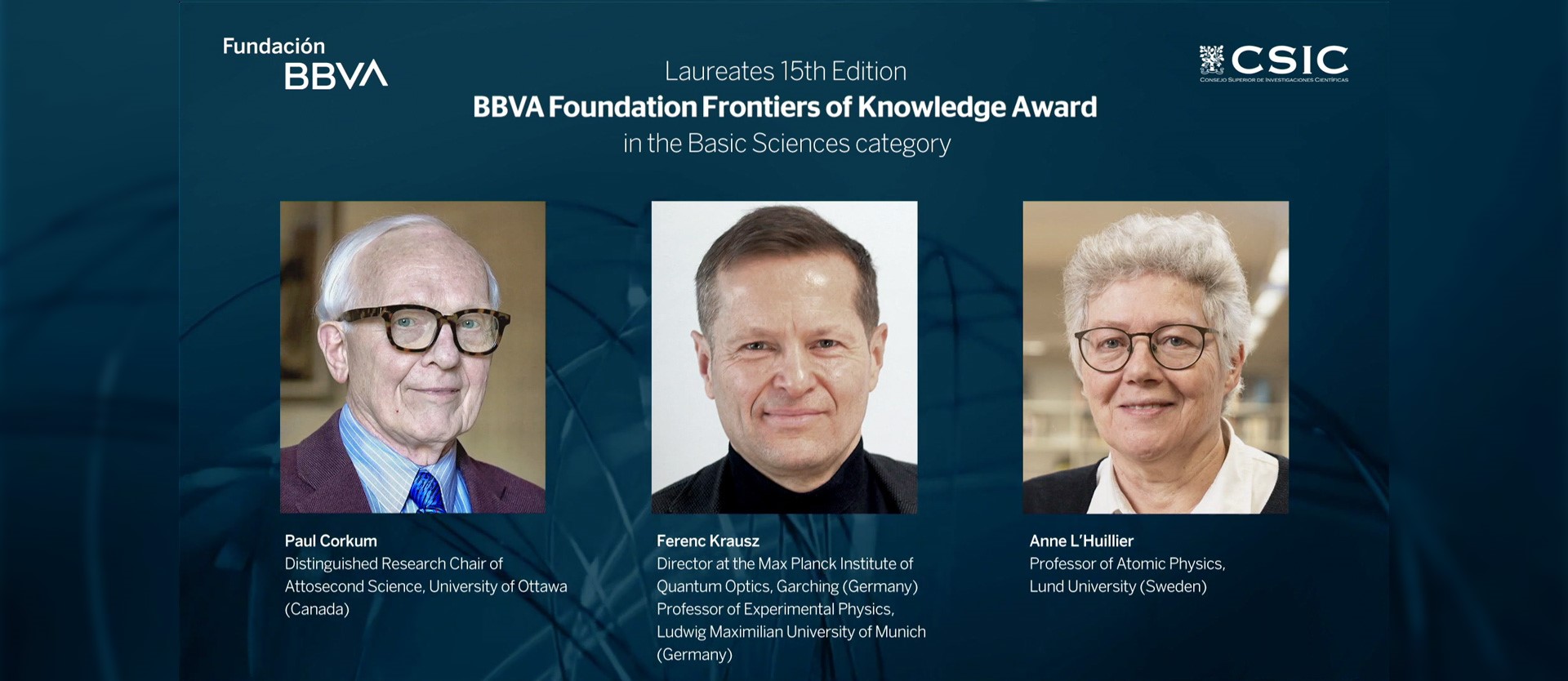
Honoring pioneers of attosecond physics
Anne L'Huillier, Paul Corkum and Ferenc Krausz to be honored with the 2023 Frontiers of Knowledge Award

How short is an attosecond? Incredibly short, like a breath of nothing. A first approximation is given by the linguistic derivation of the term. The terminus technicus is derived from the Danish word "atten", which corresponds to the number "18". This in turn is the power of ten with a negative sign, which indicates the duration of an attosecond as 10-18.
An attosecond, Paul Corkum explains, "relates to a second as a second relates to the age of the universe. Can you imagine something that short?" In numbers, an attosecond is one billionth of a billionth of a second, or 0.0000000000000001 seconds.
Attophysics, the laureate goes on to explain, "is about making the fastest measurements we can make as humans. And that is what I think puts it at the forefront of knowledge."
The laser systems developed by L'Huillier, Corkum and Krausz produce ultrashort, attosecond pulses of light that act like a camera with a shutter speed so dizzyingly fast that they can capture the motion of a hydrogen atomic electron that takes 150 attoseconds to orbit the nucleus.
"The idea is the same as when you capture the movement of a Formula One car or a bullet. You take a series of snapshots and then reconstruct how the bullet actually hits the wall," explains Ferenc Krausz. These snapshots can then be replayed in slow motion to see the movement in all its detail.
This breakthrough, based on a series of findings by the distinguished researchers, was achieved in Vienna in 2001, the year that Ferenc Krausz logically calls the "birth of experimental atomic physics." The successful experiment not only opened the door to detailed observation of electron motion, but was also able to confirm a number of predictions that had already been formulated decades ago by theoretical physics and had not been verifiable in the laboratory until then. One of these predictions is the so-called tunnel effect, a phenomenon predicted by quantum physics in which an electron is able to pass through a barrier that it theoretically does not have the energy to overcome. Although there has been some evidence that the tunneling effect exists in nature, it has never been observed in real time. Thanks to the technique of Corkum and Krausz, building on the discovery of L'Huillier, it could now be seen on "film" for the first time.
Now that attosecond physics has revealed its undeniable potential, the awardees plan to use it to probe more deeply into the mysteries of matter that make up all of nature and to develop applications in fields such as electronics and biomedicine.
"This field of research is exploding in all directions," L'Huillier says. "I've had the privilege of being there from the beginning, seeing the ideas grow and following the major steps of the process. When asked about the future of the project, she says it will "split into different subfields," as has been the case with other research areas close to her.
Krausz states that attophysics can trigger a new revolution in computing: "Electrons play an extremely important role in nanocircuits; they are responsible for switching the electric current on and off, and thus for processing information at ever-increasing speeds. If we want to speed up signal processing and build ever more powerful computers, we in turn need to understand how electrons move in these tiny dimensions. And that gives us the opportunity to push electronic signal processing to its limits."
He has also explored the potential of attosecond pulses for disease detection. When we remove all the cells from a blood sample, he explains, the fluid left is blood plasma or serum (depending on the treatment). The molecules it contains provide valuable clues about the donor's health, and the scientist is exploring ways to use attosecond pulses to obtain this information.

Even the comic hero "Flash" knows how short attoseconds are. This, however, only after the groundbreaking research results of Anne L'Huillier, Paul Corkum and Ferenc Krausz. © DC / “Superman”, Vol. 709, May 2011.
The fact that the generation of light flashes in the attosecond range has not only caused a sensation in physics, for which the three prize winners have now once again been honored with the "Frontiers of Knowledge" award, but has also meanwhile made its way into popular culture, is another rather incidental tribute to these scientists. In 2011, for example, the superhero "Flash" from the DC comic universe expressed his supposed superiority over "Superman" by saying that he can grasp things around him in less than an "attosecond”.












